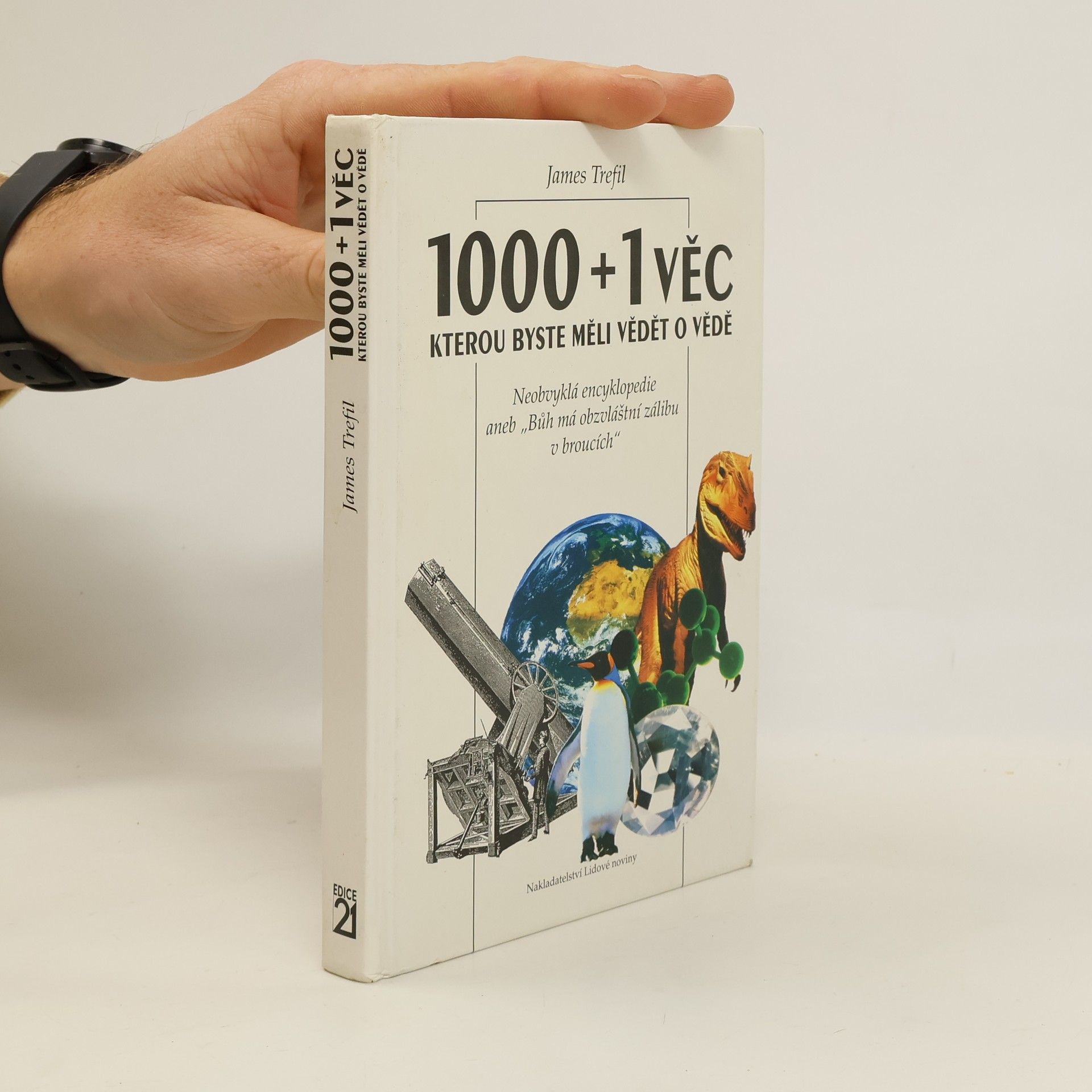1000+1 věc, kterou byste měli vědět o vědě
Neobvyklá encyklopedie aneb "Bůh má obzvláštní zálibu v broucích"
- 254 stránek
- 9 hodin čtení
Podtitul: Neobvyklá encyklopedie aneb „Bůh má obzvláštní zálibu v broucích“.
James S. Trefil se zabývá vědou pro širokou veřejnost. Ve svých knihách zkoumá otázky lidské jedinečnosti a porovnává lidskou inteligenci s umělou. Svým psaním zpřístupňuje složité vědecké koncepty a poukazuje na propojení vědy a práva.







Neobvyklá encyklopedie aneb "Bůh má obzvláštní zálibu v broucích"
Podtitul: Neobvyklá encyklopedie aneb „Bůh má obzvláštní zálibu v broucích“.
Co řídí naše geny? Jak starý je vesmír?... Autor vás zve na výpravu do světa kvantové mechaniky, černých děr, temné hmoty či kvazarů, provede vás světem molekulární biologie, dotkne se problémů skleníkového efektu a likvidace toxických odpadů a umožní vám nahlédnout do prostředí virtuální reality. Kniha se stala bestsellerem a lahůdkou pro laické milovníky vědy, které zajímají tajemství kontroverzních témat.
In this guided tour of our planetary neighborhood, the Milky Way and other galaxies, and beyond, detailed maps and fascinating imagery from recent space missions partner with clear, authoritative scientific information. For this new edition, and to celebrate the 50th anniversary of his moonwalk, astronaut and American hero Buzz Aldrin offers a new special section on Earth's moon and its essential role in space exploration past and future.
"Filled with lavish illustrations, this book is a grand tour of the universe. Three ever widening domains are presented--the planets, the stars, and the large scale universe itself--each including the ones before it and extending outward"--
Defines the people, places, sayings, and ideas representing what the authors consider essential information for literate americans
Focusing on the interconnectedness of scientific disciplines, this edition integrates physics, chemistry, astronomy, Earth sciences, and biology to promote scientific literacy. It highlights general principles and their real-world applications, making it accessible for non-science majors. The updated content addresses contemporary issues such as climate change, sustainability, viruses, public health, and bioengineering, ensuring relevance in today's scientific landscape. Praised for its clarity and detail, it serves as an effective resource for students and instructors alike.
What Every American Needs to Know - Completely Revised and Updated
"In this fast-paced information age, how can Americans know what's really important and what's just a passing fashion? Now more than ever, we need a source that concisely sums up the knowledge that matters to Americans - the people, places, ideas, and events that shape our cultural conversation. With more than six thousand entries, The New Dictionary of Cultural Literacy is that invaluable source. Wireless technology. Gene therapy, NAFTA. In addition to the thousands of terms described in the original Dictionary of Cultural Literacy, here are more than five hundred new entries to bring Americans' essential knowledge bank up to date. Are you familiar with the digital divide, European Union, Kwanzaa, pheromones, Type A and Type B personalities, spam? Or, test your knowledge on cultural icons that have stood the test of time: Odysseus, Leaves of Grass, Cleopatra, Winston Churchill, the Taj Mahal, and many, many more. Numerous original entries have been revised to reflect the many recent changes in world history and politics, American literature, and, especially, science and technology."--Jacket
James Trefil, geboren in Chicago, Professor für Physik an der George-Mason-Universität in Faifax, Virginia, war u. a. am Deutschen Elektronen-Synchrotron in Hamburg und dem Europäischen Kernforschungszentrum (CERN) in Genf tätig. Der Autor und Moderator wissenschaftlicher Radio- und TV-Sendungen wurde im Jahr 2000 mit dem Andrew-W.-Gemant--Preis des American Institure of Physics ausgezeichnet.
James Trefil, geboren in Chicago, Professor für Physik an der George-Mason-Universität in Faifax, Virginia, war u. a. am Deutschen Elektronen-Synchrotron in Hamburg und dem Europäischen Kernforschungszentrum (CERN) in Genf tätig. Der Autor und Moderator wissenschaftlicher Radio- und TV-Sendungen wurde im Jahr 2000 mit dem Andrew-W.-Gemant--Preis des American Institure of Physics ausgezeichnet.
ŚWIATOWEJ SŁAWY ASTROFIZYK I KOLEJNA OLŚNIEWAJĄCA KSIĄŻKA O ZŁOŻONOŚCI ŻYCIA I WSZECHŚWIATA. Sondy kosmiczne wyprawiają się coraz dalej, akceleratory rozbijają atomy, a radioteleskopy i teleskopy rejestrują promieniowanie wyemitowane przed miliardami lat Nasze rozumienie Wszechświata i miejsca, jakie w nim zajmujemy, zmienia się w rewolucyjny sposób. Neil DeGrasse Tyson w intrygujący sposób przymierza najnowsze koncepcje astrofizyczne do odwiecznych pytań filozoficznych: skąd się wzięliśmy?, czy jesteśmy sami?, skąd wiemy to, co wiemy?. Autor nawiązujący do wiedzy dawnych mędrców, od Eratostenesa po Galileusza, i objaśniający najważniejsze naukowe osiągnięcia teraźniejszości, takie jak odkrycie egzoplanet oraz identyfikowanie cząstek elementarnych zabiera czytelnika w podróż z przeszłości w przyszłość, od niewyobrażalnie małego do przeogromnego, od granic obecnej wiedzy ku nieznanemu. Dowcipny jak zawsze, zachęca do nieustannego patrzenia w górę i poszukiwania